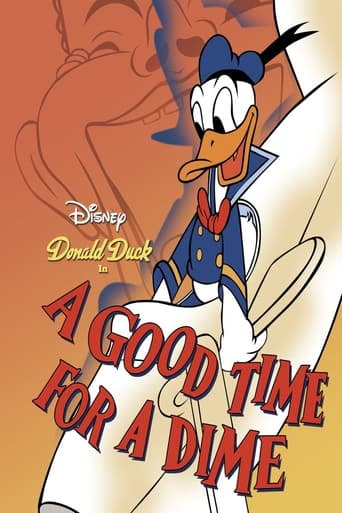MisterWhiplash
Even though Mickey Mouse was the mascot for Walt Disney pictures for many, many years (maybe still in a way, though Disney's so many things now), as a kid I always identified and liked Donald Duck more. As a kid you can get frustrated with things, especially if the world is unfair and doesn't really work properly, and if you see a cartoon like A Good Time for a Dime at the right age and more than once (I probably watched the Disney Classics VHS that had this and six other Donald Ducks countless times) it stays with you in a major way. Whether it's 'dated' doesn't really matter as its simply relatable how nothing ever really goes quite right; in that way it's like Louie or something, only with less outward, anxious aggression.What happens here? Donald goes to a carnival and checks out various things: a viewfinder from that period ("DANCE OF THE SEVEN VEILS!") and a couple of rides, and they all seem to go very wrong for him. While the final ride may be slightly his fault, it's mostly about the universe being just continually unfair to him. Naturally it's hilarious, but there's some truth to the comedy that I just didn't see in too many of the Mickey Mouse shorts. Donald seemed more like an every-man, despite his overreactions to things (or maybe because of that to a degree, whether we'd admit it or not), and this, which is a splendid series of misadventures and mishaps, is a great example of that.
TheLittleSongbird
I have always loved Disney and Donald Duck, and A Good Time for a Dime is a classic in my eyes. The premise is simple, but the efficient pace makes it entertaining, likewise with often hilarious gags, especially with Donald and the plane. A Good Time for a Dime is also interesting for Daisy's appearance in a quite risqué parody of Dance of the Seven Veils. The animation is of the colourful, vibrant quality, and the music is energetic and always action-enhancing. Donald is wonderfully temperamental, which has always been part of his charm, and while her appearance is an unusual one Daisy also impresses.All in all, this cartoon really is a good time. Highly recommended. 10/10 Bethany Cox
Shawn Watson
In that cartoon Donald Duck is visiting some kind of fair ground and stumbles upon a penny arcade. Inside he spots one of those slide-show machines with a film of Daisy stripping. He puts in his 1c only for the machine to break down before Daisy gets naked. Next he tries his luck at one of those awful claw-grab machines only for it to totally not work (come on, they NEVER work). Which, only irritates him further.Finally, Donald comes upon a model plane on a gimble rig. For 1c it looks like a lot of fun and Donald sure enjoys mimicking a fighter plane. But thew ride only lasts for a few seconds. Angry, Donald bashes the plane which soon malfunctions and goes mental on him.Funnier than it sounds, honest.
Ron Oliver
A Walt Disney DONALD DUCK Cartoon.Looking to have A GOOD TIME FOR A DIME, Donald wanders into a penny arcade and quickly begins having trouble with the machinery.Lots of humor can be found in this enjoyable little film. Daisy makes a most unusual cameo appearance as the artiste pictured in the Dance of the Seven Veils peep show. The iron claw & mechanical plane segments are also very funny. For the record, Donald only spends 8¢ in the arcade, not the dime suggested by the title. Clarence "Ducky" Nash provides Donald with his unique voice.Donald, THE VILLAGE SMITHY, has enough trouble just dealing with inanimate objects without the additional difficulty of trying to shoe Jenny, a most reluctant donkey.This humorous little film is a spoof of the classic poem by Longfellow. Jenny is very reminiscent of the tragic donkeys in the Pleasure Island sequence of PINOCCHIO (1940). Clarence `Ducky' Nash provides Donald with his unique voice.Walt Disney (1901-1966) was always intrigued by drawings. As a lad in Marceline, Missouri, he sketched farm animals on scraps of paper; later, as an ambulance driver in France during the First World War, he drew figures on the sides of his vehicle. Back in Kansas City, along with artist Ub Iwerks, Walt developed a primitive animation studio that provided animated commercials and tiny cartoons for the local movie theaters. Always the innovator, his ALICE IN CARTOONLAND series broke ground in placing a live figure in a cartoon universe. Business reversals sent Disney & Iwerks to Hollywood in 1923, where Walt's older brother Roy became his lifelong business manager & counselor. When a mildly successful series with Oswald The Lucky Rabbit was snatched away by the distributor, the character of Mickey Mouse sprung into Walt's imagination, ensuring Disney's immortality. The happy arrival of sound technology made Mickey's screen debut, STEAMBOAT WILLIE (1928), a tremendous audience success with its use of synchronized music. The SILLY SYMPHONIES soon appeared, and Walt's growing crew of marvelously talented animators were quickly conquering new territory with full color, illusions of depth and radical advancements in personality development, an arena in which Walt's genius was unbeatable. Mickey's feisty, naughty behavior had captured millions of fans, but he was soon to be joined by other animated companions: temperamental Donald Duck, intellectually-challenged Goofy and energetic Pluto. All this was in preparation for Walt's grandest dream - feature length animated films. Against a blizzard of doomsayers, Walt persevered and over the next decades delighted children of all ages with the adventures of Snow White, Pinocchio, Dumbo, Bambi & Peter Pan. Walt never forgot that his fortunes were all started by a mouse, or that simplicity of message and lots of hard work will always pay off.
